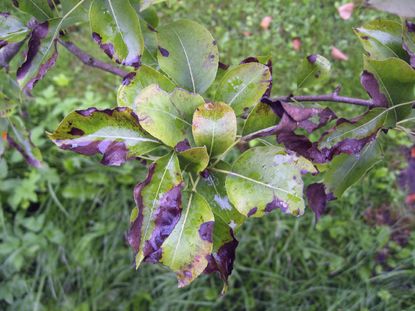Pear Tree Issues – Tips On Fixing Pear Tree Problems


If you have an orchard with pear trees, expect to encounter pear tree diseases and pear tree insect problems. The two are related, since insects can spread or facilitate other pear tree issues. As a gardener, you can prevent many problems with pears by appropriate spraying and pruning. Read on for more information about fixing pear tree problems.
Pear Tree Diseases
Several pear tree diseases can attack your trees. Since these tend to occur in a regular sequence, you can anticipate them and take protective action where possible.
Fire blight
The most devastating problems with pears come from a disease called fire blight, caused by the bacterium Erwinia amylovora. The bacteria can remain in the area over the winter in fallen fruit or new shoots. With the spring warmth, it multiplies rapidly and you’ll see a liquid oozing from tree tissues. Insects carry this ooze to blossoms and infect them in turn. The key to controlling fire blight is sanitation. Fixing pear tree problems with fire blight requires that you remove all old fruit and fallen foliage from the orchard. Prune back wounded or cankered branches – at least 8 inches (20 cm.) below the problem area – and burn or dispose of them during winter. If you are just installing pear trees, look for cultivars with some resistance to this disease.
Fabraea leaf spot
Other common diseases that damage pear trees include Fabraea leaf spot, caused by the fungus Fabraea maculate. Keep a look out for dark spots on leaves that then yellow and fall. Cankers appear on fruits too, and cause them to crack. Again, sanitation is essential to controlling this disease. Removal and disposal of all fallen leaves significantly reduces the chance that your pears will get leaf spot. Fungicide spray can also help control the disease.
Pear scab
Pear scab, like apple scab, is caused by the fungus Venturia pirina. You’ll see circular, velvety dark spots on the tree’s leaves, fruit, and twigs. Over time, they turn gray and cracked. Since the fungus lasts out the winter on dead leaves, sanitation is again critical. Fungicide sprays are also effective.
Sooty blotch
If you see sooty smudges on the pear fruit, your tree may have another one of the most common pear tree diseases, sooty blotch, which is also common in apples. It is caused by the fungus Gloeodes pomigena. The blotches occur when the weather is wet or humid, but they can be washed off with soap and water. Good air circulation helps prevent this disease, so cut back grass and nearby shrubs.
Pear Tree Insect Problems
The codling moth is one of the most serious pear tree insect problems. They lay eggs on the fruit, and the larvae bore into the fruit as they develop. Another of the most common pear tree insect problems is called pear psylla. Again, these are insects that lay eggs on the pear trees. The hatching nymphs attack fruit and foliage, secreting a sweet liquid termed honeydew. Aphids and ants are attracted to the honeydew, so their presence is a sign that your tree may have the disease. Infected leaves can look burned and fall from the trees. Fixing pear tree problems involving pear psylla involves using dormant oil sprays during the tree’s dormancy. This winter spray also smothers other insect-related problems with pears, such as infestation by pear-leaf blister mites. These can also cause ornamental pear tree issues. Oil applications every seven days can also reduce spider mite infections.
Gardening tips, videos, info and more delivered right to your inbox!
Sign up for the Gardening Know How newsletter today and receive a free download of our most popular eBook "How to Grow Delicious Tomatoes."

Teo Spengler has been gardening for 30 years. She is a docent at the San Francisco Botanical Garden. Her passion is trees, 250 of which she has planted on her land in France.
-
 Urban Composting Guide: How To Compost In The Middle Of The City
Urban Composting Guide: How To Compost In The Middle Of The CityUrban composting does not have to be daunting. You can compost in the city, and maybe even try some urban worm composting!
By Mary Ellen Ellis
-
 Shrub Diseases And Pests To Watch Out For
Shrub Diseases And Pests To Watch Out ForShrub diseases and pests can be challenging. Learn how to recognize and eradicate them before they can present a danger to your plants.
By Susan Albert